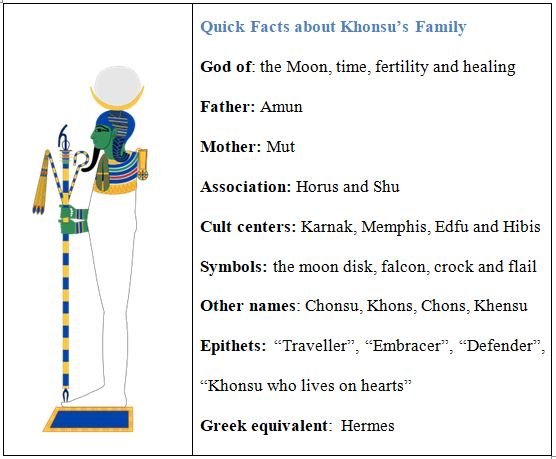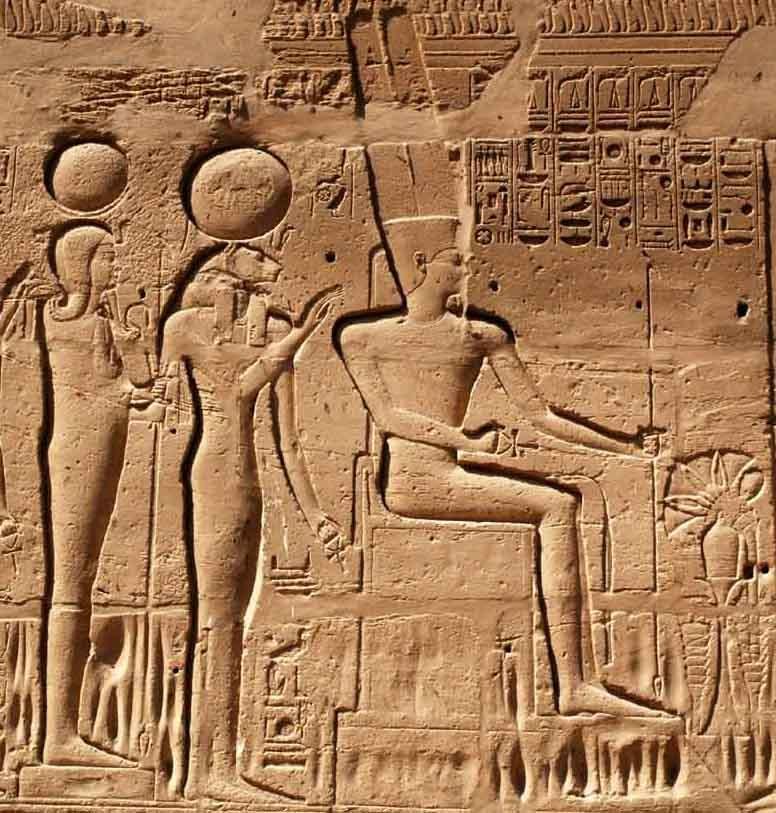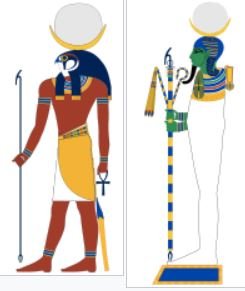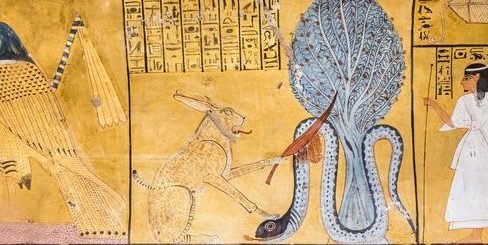Khonsu: Ancient Egyptian God of the Moon and Time

Khonsu – Ancient Egyptian god of the Moon, fertility and time
After the ancient Egyptian goddess Nut (sky goddess and protector of Egypt) was forbidden from giving birth on any day of the 360-day year, she gambled with Khonsu, the god of the Moon and time. Khonsu is believed to have lost out on the bet, allowing Nut to win five extra days so she could give birth (to Osiris, Isis, Seth, and Nephthys, and Horus the Elder).
As the god of time, Khonsu was an extremely influential deity in the Egyptian pantheon. It was believed that he played a very important role in creating living things. He was a member of the famous Theban Triad (or the Triad of Waset), which included his mother Mut (the sky mother goddess) and his father Amun (the creator deity). Some of his most famous temples and cult centers were also in the city of Thebes.
Read on to learn more about the origin, evolution, symbols, and powers of Khonsu, the ancient Egyptian god believed to be the embodiment of the light from the crescent moon.
Birth story and his evolution from a blood-thirsty deity to a benevolent god
In the era before the New Kingdom, many ancient Egyptian texts (i.e. the Pyramid Texts and the Coffin Texts) described Khonsu as a very ferocious and dangerous god who had an insatiable appetite for blood. According to the “Cannibal hymn”, he often connived with dead Egyptian kings to capture and feed on many Egyptian gods. By so doing, the kings would absorb the strength of the gods.
Such was his wanton and malevolent nature that the Coffin Texts described him as: “Khonsu who lives on hearts” or “Khonsu the Cannibal” or “Khonsu the Blood-thirsty One”.
Fast forward to the New Kingdom, his attributes took a U-turn; no longer was he associated with malicious activities, instead he was seen by Egypt as a very benevolent deity. He was typically revered as the “Greatest God of the Great Gods”.

Khonsu and The Theban Triad | Image (from left to right) – Khonsu, Mut, and Amun-Re (enthroned)
Egyptians in the New Kingdom believed that Khonsu was the divine son of the creator god Amun and the mother goddess Mut. Also, he was believed to be Amun’s first and greatest son (“Khonsu the Child” – “Khonsu pa-khered”). For example, his most common feature – his sidelock – symbolized his youthful side.
Together with his parents, Khonsu made up the famous Theban Triad, whose temples were found all across city of Thebes.
At Kom Ombo however, Khonsu was seen as the son of the sky goddess Hathor and the crocodile god Sobek. The inhabitants of Edfu saw him as Osiris’s son (“son of the leg”).
Read More:
- Myths and Facts about Seth, the god of chaos and the desert
- Everything you need to know about Maahes, the Lion-headed God of War
- Nephthys – the Egyptian Goddess of Death and the Night
What does Khonsu’s name mean?
As the embodiment of the crescent moon’s light, Khonsu’s name often evokes a meaning of “travelling” or “to cross”– a testament to his travels across the sky at night.
His name has also been associated with royalty, particularly the royal placenta. According to the myth, Khonsu transformed himself into the Great Snake at the dawn of time and fertilized the Cosmic Egg.
The people of Thebes called him “Khonsu nefer Hotep” or the “Defender or Lord of Ma’at”. In ancient Egypt, Ma’at was the goddess of law, justice and order. Hence, Khonsu’s role in the pantheon was to defend the just and truthful in the land.
Epithets
Owing to his association with the Moon, he was given the name “mighty bull” whenever there was a new moon. His name, however, changed to the “Castrated Bull” when there was a full moon.
Other very important epithets of the ancient Egyptian god Khonsu include: “Embracer”, “He who traverses”, “the Decider of the Life Span” and “Pathfinder”.
Khonsu’s role in ancient Egypt
First and foremost, Khonsu was the god of the moon and time. It was believed that he was responsible for making the Moon shine; illuminating the night life of the Egyptians. He has the ability to manipulate time and even add new days to the year.
As a lunar deity, he also had vast amounts of powers to make people, as well as cattle, very fertile. This feature of his is why he was seen in some era as the deity who created the world.
As a moon god, Khonsu was linked to fertility because ancient Egyptians, like many other ancient civilizations, believed that the moon symbolized menstrual cycles. As such, he was revered as the deity that helped not just livestock to grow strong and healthy, but also plants and flowers.
In addition to being the god of love and fertility, he was responsible for protecting people. He was believed to keep watch over people that travelled at night.
He was one of the deities ancient Egyptians called on to protect them against wild creatures at night. He had complete dominion over all nefarious creatures on land, at sea and in the sky.
Finally, Khonsu was seen as one of the deities with extreme healing abilities. Often times, the kings of Egypt offered sacrifices to him when the land was suffering from diseases. It was believed that he could blow fresh air all across the land, healing people that were sick or despondent. This trait of his meant that he was often associated with Shu, the god of air and moisture.
Symbols and Depictions

Khonsu – symbols and appearances | Image: Khonsu depicted as a falcon-headed god (left) and a green-skinned god with a curved beard
Khonsu was predominantly shown as a mummified man with his arms crossed. As result, he skin color was green.
Other very important features of his were his sidelock of hair and the crescent-shaped necklace that he wore around his neck.
When he is not depicted with a man’s head, he is shown with either an eagle’s or falcon’s head. His headdress is often made of a lunar disc and a crescent moon.
In some cases, he can be seen holding a royal staff with the Djed and the Was symbols – ancient Egyptian symbols of stability and power respectively. Likewise, the crock and flail that he held in his hands represented protection and power (i.e. rulership) respectively.
Did you know: the Cynocephalus baboon was an important symbol of Khonsu?
Worship of Khonsu
During the Ramesside period (i.e. in the New Kingdom), Khonsu’s worship was very widespread. A huge temple was built at Karnak in his honor. Construction of the temple – the Great Temple of Khonsu – was started by the 20th Dynasty pharaoh Ramesses III and later completed by his successors.
At Thebes, he and his parents – Mut and Amun – were worshiped as the Theban Triad.
Other interesting myths about Khonsu

Khonsu at Karnak with a falcon head
- The commonest god that he is often associated with is Thoth, the god of wisdom, knowledge and time. In some myths, Thoth was the one who bargained with Khonsu to have five days added to the year in order for the goddess Nut to give birth.
- As result of his association with the Moon (crescent moon), he was given the name “Khensu-pa-khart”.
- According to the myth, he usually took the form of a child (“Khonsu pa-khered) in the morning, and in the evening, he turned into an old man.
- He was not solely associated with the Moon but also the Sun – the spring sun – at the start of every month. This explains why he is depicted with the Sun disk and the crescent moon. What this meant was that: He sometimes took the traits of other solar deities such as Min, Ra and Horus, especially in Thebes.
- He was known as “Khonsu-Djehuti” in the city of Hermopolis (Khumnu).
- An ancient stele record (the Bentresh Stele located in the Louvre Museum) stated that a princess of Bekhten was cured after gazing at the image of Khonsu. The princess’ brother approached Ramesses II and asked for his help in healing the princess. The pharaoh responded by sending his best doctors, as well as a statue of Khonsu, to heal the ill princess. It was believed that Khonsu fiercely fought against and defeated the demon that was causing the princess’ illness.
- During the Ptolemaic era (the Graeco-Roman Period), Ptolemy IV gave himself the title “Beloved of Khonsu Who Protects His Majesty and Drives Away Evil Spirits” shortly after Khonsu healed him.
- The five days that the goddess Nut won from Khonsu came to be called the “devil days”. This myth also explains why we now have an average of 365 days a year instead of the 360 days that existed prior.




























this is the most helpful resource I could find on the internet, it is very detailed and has a bunch of helpful information.